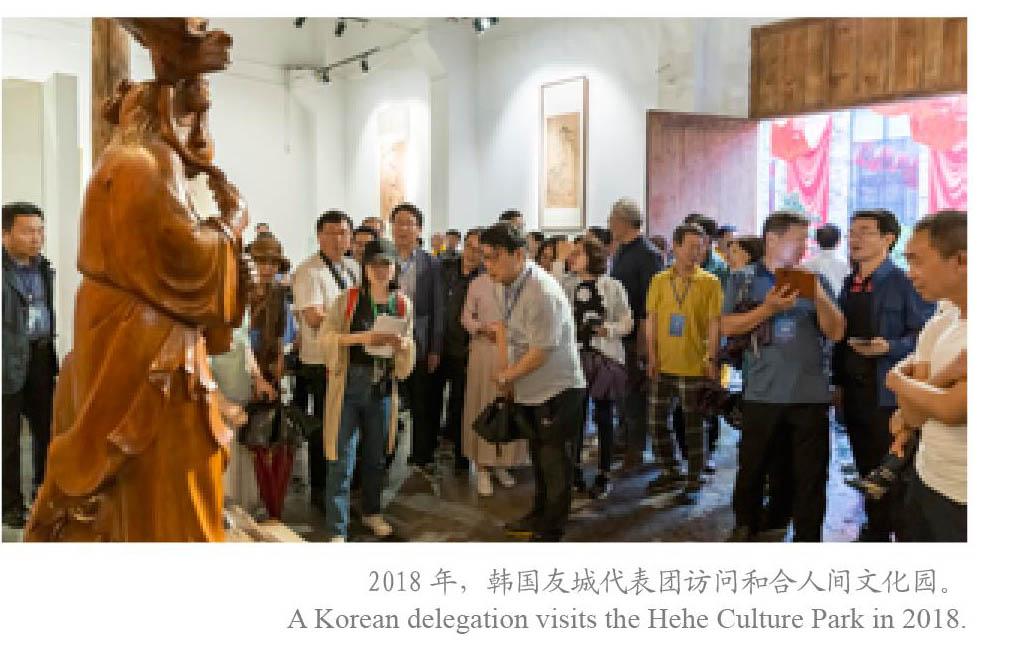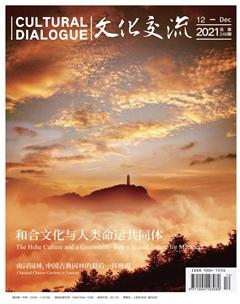沈中明的和合情怀
刘凡力 张涵涵


浙江天台山,钟灵毓秀的自然风貌,鼓荡出吐纳山海的壮美气象,涵育出中华文化最为动人的和美光华。这里是中华和合文化的发祥地,和合理念家喻户晓、深入人心。
在天台,谈及和合文化,不得不提沈中明与和合人间文化园。沈中明,天台县人,浙江明丰实业股份有限公司董事长、浙江省汽车用品行业协会会长,从小受和合文化的熏陶与影响,并受益良多,对和合文化情有独钟。早年,国内没有专门保护宣传和合文化的主题场所,在寒山、拾得留下过足迹与传说的地方建一座以和合为主题的文化园,成为沈中明先生挥之不去的情怀。
2008年,明丰公司搬迁新址,20世纪70年代的老厂房正好用于改造再利用,为和合人间文化园的创办提供了契机。在沈中明心目中,传承发展中华优秀传统文化是义不容辞的责任,建和合人間文化园必将利国利民、泽被后人,比商业开发更有意义。于是,他与儿子沈盛钢开始组建团队,进行前期规划建设,由沈盛钢负责向海内外征集与和合文化相关的文物史料。筹建期间,添置文体设施,将场所无偿提供给市民开展文化体育活动,30余万人次受益于这一善举。
历经几年艰辛,2015年5月16日,中国首座和合文化主题博物馆——天台和合博物馆建成开馆,落户和合人间文化园,对征集的3000多件和合文化实物及史料,进行集中保护和展出。全球和合史料库初具规模,成为讲述和合文化的重要窗口和活动基地。开馆至今,接待海内外专家学者和游客等超50万人次。
目前,和合人间文化园积极与美国、日本、韩国、加拿大等国开展主题交流活动,接待各国访问团参观考察;参与推动加拿大中国和合文化研究会、日本东京和合文化驿站成立,在和合文化的海外传播中起到了极大的促进推动作用。
此外,和合人间文化园相继建成一根藤艺术馆、满堂红婚俗馆等。一根藤艺术馆共征集了500多件各个时期的“一根藤”经典作品,进行保护、展示、传承。同时,成立“一根藤工坊”,用于培养传承人及开发衍生作品。作品多次获国家级、省级、金奖、银奖,中央电视台四套、九套、十套,央视网、央视频等给予专题报道,广为传播。满堂红婚俗馆通过重现传统地方婚庆场景,弘扬“忠孝仁爱、家庭和合”的传统美德。
和合人间文化园的有序建设,圆了沈中明最初的“和合梦”,每一次的提升都凝聚了他的心血与智慧。沈中明对和合文化保护、传播、弘扬的坚定与执着,让他在当地赢得了“和合文化传播大使”的美誉。
Shen Zhongming and His Love for the Hehe Culture
By Liu Fanli Zhang Hanhan
Tiantai Mountain in Zhejiang province is known for its charming sceneries and magnificent peaks. Indeed, around Tiantai Mountain lies the quintessence of the Chinese culture, for it is the cradle of the Hehe culture, and it is the place where the idea of Hehe (harmony and cooperation) has long grown into the hearts of local people.
In Tiantai county, when it comes to the Hehe culture, we cannot get past Shen Zhongming and the Hehe Cultural Park he helped build. Born in Tiantai county, Shen is the chairman of the board at Zhejiang Mingfeng Industrial Co. Ltd., and president of Zhejiang Car Utilities Industry Association. Nurtured by the Hehe culture since his childhood, Shen took a special liking to the concept at a very young age, and has reaped a lot of benefits from it.
In the early days, there were no places or areas specially allocated for the promotion and protection of the Hehe culture in China. Therefore, setting up a Hehe-themed cultural park to commemorate Hanshan and Shide, two legendary monks who once lived as recluses on Tiantai Mountain during the Tang Dynasty (618-907) and who have been regarded as symbols of the Hehe culture, became Shen’s quest.
In 2008, as Shen’s company, Zhejiang Mingfeng Industrial Co. Ltd., was ready to move to a new site, the old factory buildings from the 1970s had to be renovated, which provided an opportunity for the establishment of a Hehe Cultural Park. In Shen’s mind, it is his bounden responsibility to pass on and promote the best of traditional Chinese culture, and building a Hehe cultural park was bound to bring a lot of benefits to the nation, the people and, more importantly, the future generations. It was much more rewarding than a commercial undertaking.
Together with his son, Shen began working in earnest. They organized a team for the planning and the construction work, and Shenggang, Shen’s son, was put in charge of collecting cultural relics and items, as well as historical documents and materials on the Hehe culture from home and abroad. During the preparations, sports facilities were put in place, which local residents could freely enjoy.
After several years of hard work, the Tiantai Hehe Museum, China’s first Hehe culture-themed museum, officially opened to the public on May 16, 2015, inside the newly launched Hehe Culture Park. More than 3,000 items and historical documents on the Hehe culture were collected, protected and exhibited at the museum. At the same time, the Global Database on Hehe History also began to take shape. Since then, the Tiantai Hehe Museum has become an important window and base for the dissemination of the Hehe culture. So far, the museum has received more than 500,000 visitors, including many prominent Chinese and international experts and scholars.
At present, the Hehe Culture Park serves as an education base not only for the Party School of the CPC Zhejiang Provincial Committee and the Organization Department of the CPC Taizhou Municipal Committee, but also a Hehe culture research base for Renmin University of China. The park has carried out international exchanges on the Hehe culture with the United States, Japan, Korea, Canada and other countries, and helped establish the Hehe Culture Research Association in Canada and the Hehe Culture International Center in Tokyo, Japan, playing a great role in promoting the overseas dissemination of the Hehe culture.
Since then, a hall showcasing marriage customs and a “one rattan” gallery have also been set up. Born in the late Ming (1368-1644) and the early Qing (1616-1911) period, “one rattan” is a unique traditional wooden craftsmanship technique in Tiantai. Using wood strips of different lengths that are put together with mortise and tenon joints, the craftsmen then loop and twist the strips into different patterns without beginning or end, a symbol for harmony. It is so named because the works are shaped like the rattan palm trees in the mountains of Tiantai county. With over 500 pieces of classic works from various periods, the gallery also contains a workshop for the cultivation of inheritors.
The smooth development of the Hehe Culture Park is a dream come true for Shen Zhongming. Each step forward is a result of his painstaking efforts and wisdom. In fact, Shen’s commitment to the protection, dissemination and promotion of the Hehe culture has earned him the reputation of the “Hehe Culture Ambassador” in the local community.

